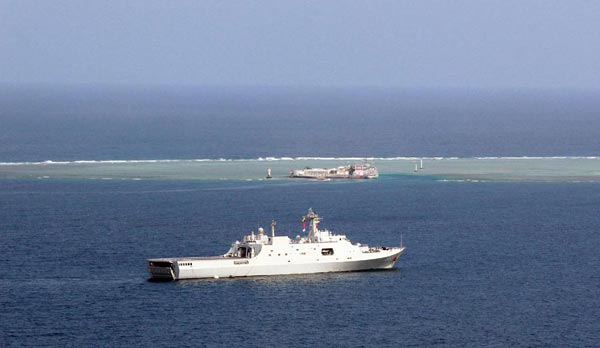US actions cause of tensions in South China Sea
Updated: 2016-04-20 08:11
By Wang Hui(China Daily)
|
||||||||
 |
|
A formation of the Nanhai Fleet of China's Navy on Saturday finished a three-day patrol of the Nansha islands in the South China Sea. [Photo/Xinhua] |
When US Defense Secretary Ash Carter said on board a US aircraft carrier in the South China Sea on Friday that "what's new is the context of tension which exists which we want to reduce," he did anything but that. Instead, he further raised tensions in the waters.
The US defense chief's muscle flexing reflected the United States' determination to step up its involvement in the South China Sea.
This is the second time in five months that the Pentagon chief has boarded a US aircraft carrier sailing through disputed waters in the South China Sea. These are more than just symbolic moves. They are part of a series of maneuverings by the US as it shifts to the fore in the waters in its bid to contain China.
Since October, Washington has repeatedly employed the excuse of freedom of navigation to sail navy vessels through China's territorial waters without permission.
On Oct 27, the guided-missile destroyer USS Lassen entered the waters around China's Zhubi Reef in the South China Sea where reconstruction work was being completed. And on Jan 30, the US Navy guided missile destroyer USS Curtis Wilbur entered Chinese waters off the Xisha Islands. The US has said it will step up the frequency of such sail-bys.
These provocative moves have been hailed by the US' allies that have territorial disputes with China, but it is worth mentioning that some Western media are now describing the US' actions as "assertive", (although still unfairly portraying China as being in the wrong by labeling its previously "assertive" behavior as "aggressive").
This does point to the prevailing and disturbing trend in the South China Sea: China and the US seem to be increasingly engaged in a form of hand wrestling, with the US resorting to one provocation after another and China being compelled to take countermeasures.
Carter boarded the aircraft carrier USS John C Stennis last week, soon after Fan Changlong, China's vice-chairman of the Central Military Commission, had inspected the construction of facilities on some islands and reefs of the Nansha Islands.
Fan's visit was widely interpreted as a warning to countries, including the US, that China will not compromise its maritime territorial integrity and is determined to react to any provocations, so Carter's move was seen as challenge to this.
Since last year, the US has been leading a chorus with countries such as the Philippines and Vietnam to point an accusing finger at China's island reclamation work despite China's repeated explanation that the work falls within China's sovereignty and is largely meant for civilian purposes and will also provide support to foreign vessels in the waters.
On Sunday, a People's Liberation Army Navy aircraft suspended its patrolling of the South China Sea to help transport three severely ill patients from Yongshu Jiao reef of the Nansha Islands to Sanya in Hainan province.
This is a ready proof that China's new facilities on the Nansha Islands contribute to dealing with emergencies and providing humanitarian support to all vessels passing through the waters.
Despite the fact that more than 40,000 vessels sail through the South China Sea every year, no single incident has been reported that China's reclamation work has in anyway impeded freedom of navigation in the waters. This clearly shows the US' "upholding" of freedom of navigation in the waters is a false proposition. It is only an excuse used by the US to realize its strategic intentions in the region.
What has happened in the past months should raise the alarm as the US' meddling in the South China Sea has indisputably complicated the situation, pushed it toward head-on conflict, and made it more difficult for the parties concerned to find peaceful solutions to their territorial disputes.
The author is deputy editor-in-chief of China Daily Asia Pacific. jasmine@chinadailyhk.com
- Global health entering new era: WHO chief
- Brazil's planning minister steps aside after recordings revelation
- Vietnam, US adopt joint statement on advancing comprehensive partnership
- European border closures 'inhumane': UN refugee agency
- Japan's foreign minister calls A-bombings extremely regrettable
- Fukushima impact unprecedented for oceans: US expert

 Stars of Lijiang River: Elderly brothers with white beards
Stars of Lijiang River: Elderly brothers with white beards
 Wealthy Chinese children paying money to learn British manners
Wealthy Chinese children paying money to learn British manners
 Military-style wedding: Fighter jets, grooms in dashing uniforms
Military-style wedding: Fighter jets, grooms in dashing uniforms
 Striking photos around the world: May 16 - May 22
Striking photos around the world: May 16 - May 22
 Robots help elderly in nursing home in east China
Robots help elderly in nursing home in east China
 Hanging in the air: Chongqing holds rescue drill
Hanging in the air: Chongqing holds rescue drill
 2.1-ton tofu finishes in two hours in central China
2.1-ton tofu finishes in two hours in central China
 Six things you may not know about Grain Buds
Six things you may not know about Grain Buds
Most Viewed
Editor's Picks

|

|

|

|

|

|
Today's Top News
Liang avoids jail in shooting death
China's finance minister addresses ratings downgrade
Duke alumni visit Chinese Embassy
Marriott unlikely to top Anbang offer for Starwood: Observers
Chinese biopharma debuts on Nasdaq
What ends Jeb Bush's White House hopes
Investigation for Nicolas's campaign
Will US-ASEAN meeting be good for region?
US Weekly

|

|







